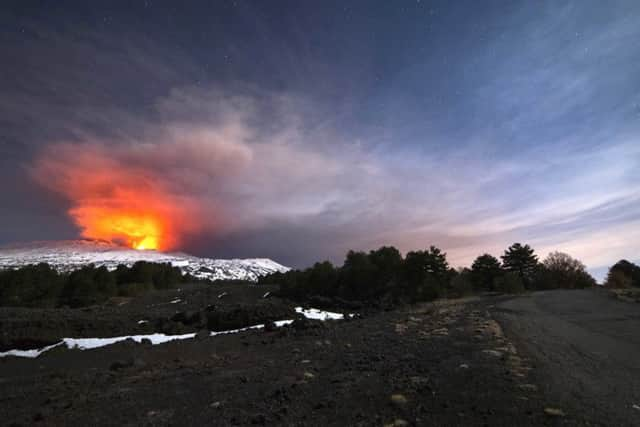Scientists, tourists and BBC crew hurt in Mount Etna eruption


The Catania operation centre of Italy’s volcanology institute confirmed that members of a team taking measurements on the active volcano had been injured, but had no details on the numbers involved or the seriousness of the injuries.
The Catania Today website reported that at least three volcanologists were on the volcano when the explosion occurred just before noon, and that some were injured.
Advertisement
Hide AdAdvertisement
Hide AdA BBC journalist and camerawoman on assignment at the volcano were among the injured.
Their film shows an explosion of steam followed by a second explosion of boiling rocks and people running away from the explosion.
The clip continues in a snowcat, where a man holds a paper towel to stanch the bleeding from his head and hugs his wife.
Authorities say about 35 tourists were on the volcano when the explosion occurred around midday, and that the guides who accompanied them helped bring them to safety.
The president of the Italian Alpine Club chapter in Catania, Umberto Marino, said he was traveling up the volcano in a snowcat when injured people started running in his direction.


“The material thrown into the air fell back down, striking the heads and bodies of people who were closest,” Marino was quoted by the Catania Today website as saying.
According to Italian news agency ANSA, four people including three German tourists were hospitalised, mostly with head injuries. None of the injuries were listed as grave.
Italy’s volcanology institute said the explosion took place at about 8,858ft above sea level, putting the tourists at more than 1,640ft below the base of the newest southeast Mount Etna crater where the lava flow originated.
Advertisement
Hide AdAdvertisement
Hide AdAmong those present when the explosion occurred was a scientist from Italy’s volcanology institute, Boris Behncke, who said on his Facebook page that he had suffered a bruise to his head.


“I am generally fine and having a good, well-deserved beer in this moment,” he added.
The BBC’s global science reporter, Rebecca Morelle, was on assignment on Etna and described the experience in a series of tweets.
“Running down a mountain pelted by rocks, dodging burning boulders and boiling steam - not an experience I ever ever want to repeat,” Morelle wrote.
The BBC crew was shaken but physically OK despite having suffered cuts, bruises and burns, she wrote.


Morelle later showed her colleague’s jacket on air with a big hole in the back where the material had melted in the explosion.
Morelle said the explosion was “a reminder of how dangerous (and) unpredictable volcanoes can be.”
Mount Etna has been active for the past two days, creating a visual spectacle as it spews lava and ash into the air. A new lava flow started from the southeastern crater on Wednesday, and was advancing with a temperature above 1,000 degrees Centigrade in an area covered by snow, creating the explosion.
Advertisement
Hide AdAdvertisement
Hide AdOfficials at nearby Catania airport announced Thursday they would reduce arrivals by half to five flights an hour due to Mount Etna’s ash clouds. Departures were continuing as scheduled.
Thousands of tourists each year visit Etna, one of the world’s most active volcanoes located on the eastern coast of Sicily. Eruptions occur frequently, although incidents that involve injured tourists are rare.